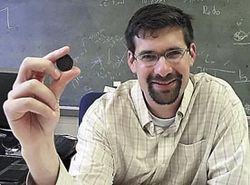
PREV ARTICLE
NEXT ARTICLE
FULL ISSUE
PREV FULL ISSUE
V11 2008 INDEX
E-SYLUM ARCHIVE
PROFESSOR TRACES U.S. CENT COPPER TO THE MINES WHICH PRODUCED IT
A Juniata College professor combined his expertise in
geology with his interest in numismatics to trace the origins of copper
used to produce U.S. cents. -Editor
 If someone gave Ryan Mathur a penny for his
thoughts, they would learn much more than they bargained
for.
If someone gave Ryan Mathur a penny for his
thoughts, they would learn much more than they bargained
for.Mathur, an associate professor of geology at Juniata College, is the first researcher to discover that tracing the copper used in U.S. pennies correlates directly to the mine that produced the metal.
He plans to publish his findings in the Journal of Archaeological Science in November.
Mathur, who also is a coin collector and a geologist specializing in copper ore deposit research, said copper has two isotopes that give off distinct "geo-chemical signatures" depending on the ratio of each isotope the ore deposit was taken from.
Like many Americans, he just happened to have a penny in his pocket.
He tested that penny - and several others - and discovered that the copper in the pennies minted in the 19th and 20th century came from a single source with a specific signature.
Mathur decided to trace the copper in historic pennies to see if he could match the penny to the deposits where the copper originated.
He cut a sample from the penny - defacing currency in the name of science - and dissolved a portion of the copper in acid.
Mathur then suspended it in a solution and used a mass spectrometer from the University of Arizona to obtain the signature of the metal.
"This is important because we've only had the ability to measure copper isotopes reliably in the past 16 or 17 years, and that's relatively recent in science terms," Mathur said.
At the same time, he had to research the origins of copper bought by the U.S. government during the course of American history.
He delved into the Archives of the U.S. Mint in Philadelphia and found that from 1810 to 1981, 95 percent pure copper was used to mint pennies.
Copper used to mint pennies from 1810 to 1835 came from a site in Cornwall, England.
From 1835-44, the U.S. government bought copper from a variety of sources. Starting in 1845, most of it came from a giant deposit in Michigan.
Then, in 1872, the U.S. began purchasing copper from sources around the world as a way to protect domestic resources. The government later returned to using copper from Montana and Arizona, Mathur said.
To make the link between currency and the copper site, Mathur spent $150 to purchase an 1810 penny from a Huntingdon coin dealer.
Then he hunted down a sample from the Cornwall mine at the Carnegie Museum of Natural History in Pittsburgh.
By separately testing the penny and the deposit sample, Mathur found their signatures lined up.
Mathur also traced pennies minted in Denver to the Anaconda mine in Butte, Mont., and other domestic deposits.
Using identifying signatures from ore deposits can be applied to any object made from or containing copper to see if that copper originated at those sites, Mathur said.
To read the complete article, see: Penny-wise (http://www.altoonamirror.com/page/content.detail/id/512084.html?nav=742)
Wayne Homren, Editor
The Numismatic Bibliomania Society is a non-profit organization promoting numismatic literature. See our web site at coinbooks.org.
To submit items for publication in The E-Sylum, write to the Editor at this address: whomren@gmail.com
To subscribe go to: https://my.binhost.com/lists/listinfo/esylum
All Rights Reserved.
NBS Home Page
Contact the NBS webmaster
